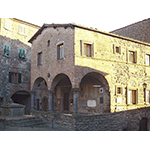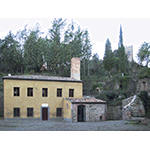Museo delle Miniere di Montecatini [Mine Museum of Montecatini]
Despite the fortunes of the mining site can be set between the early 19th century and the early 20th century, the first documented news dates back to 1469 and continued, with changing fortunes, up to 1827 when – as historian and natural scientist Emanuele Repetti recalls in his Dizionario geografico fisico storico della Toscana - the exploitation of the mine was resumed. The town was undoubtedly a very important centre for the extraction of copper, so much indeed that it gave its name to one of the most important mining industries of Europe: Montecatini, later named Montedison.
The Museum is located in the historical Palazzo Pretorio (12th century, though restructured several times), seat of city government until 1953. Inside the loggia of the building is a plaque that compares the old units of measure with those adopted by the Decimal Metric System. The facade of a house opposite the palazzo has a marble sundial.
The Museum presents the documentation of mining activity between 1827 and 1927. It is part of a fascinating territorial exhibition circuit that illustrates the spots tied to the extraction of minerals. Among these, noteworthy is the site of Caporciano, the richest copper mine in Europe, with the entrance to the mine where the system of tunnels and winzes begins, the surrounding constructions, reserved mostly to administrative functions, and the porter’s lodge from which watchmen controlled the access to the mine and offices.
Proceeding along the road above the main entrance of the mine of Caporciano, we reach Pozzo Alfredo, the main site of ore extraction. Inaugurated in 1855 with its approximate 315 metres in depth, it joined the various levels of tunnels. The shaft was equipped with a steam machine fuelled by two boilers that extracted the ore and introduced the materials necessary for the miners’ operations.
Finally, the Muraglione dam performed the task of guaranteeing the mine’s water needs.
Admirably restored, the complex forms an efficient historical itinerary in the field of copper extraction from the technical-scientific viewpoint, as well as from the social perspective.
****************************
Texts by Graziano Magrini
English translation by Victor Beard
Last update 04/gen/2008





